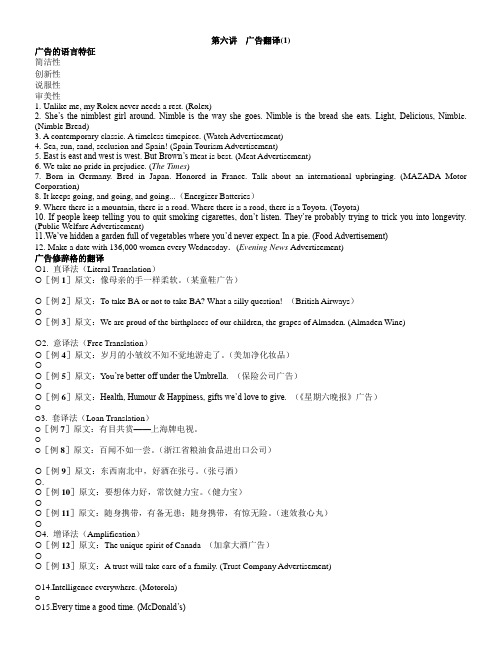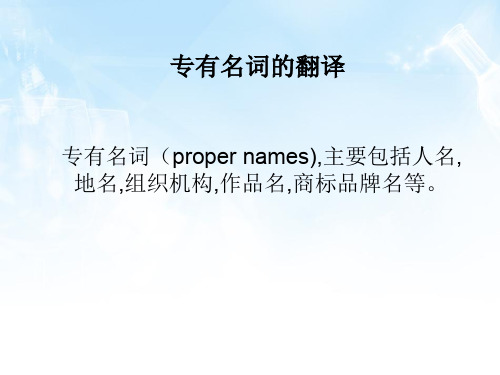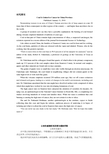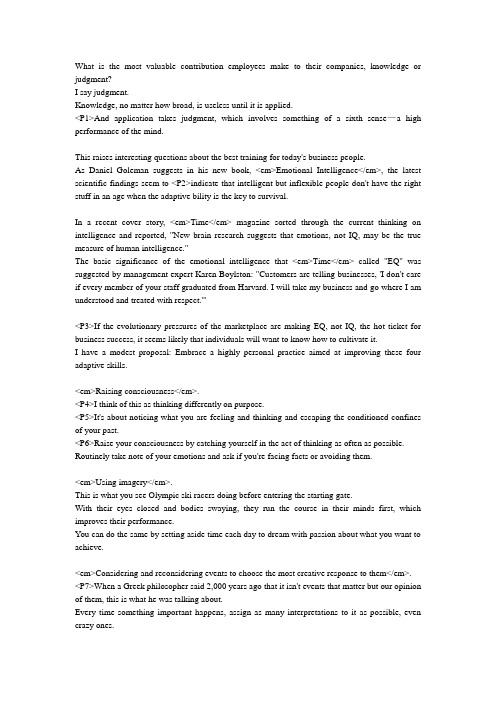时代周刊翻译
第六讲广告翻译

第六讲广告翻译(1)广告的语言特征简洁性创新性说服性审美性1. Unlike me, my Rolex never needs a rest. (Rolex)2. She’s the nimblest girl around. Nimble is the way she goes. Nimble is the bread she eats. Light, Delicious, Nimb le. (Nimble Bread)3. A contemporary classic. A timeless timepiece. (Watch Advertisement)4. Sea, sun, sand, seclusion and Spain! (Spain Tourism Advertisement)5. East is east and west is west. But Brown’s m eat is best. (Meat Advertisement)6. We take no pride in prejudice. (The Times)7. Born in Germany. Bred in Japan. Honored in France. Talk about an international upbringing. (MAZADA Motor Corporation)8. It keeps going, and going, and going...(Energizer Batteries)9. Where there is a mountain, there is a road. Where there is a road, there is a Toyota. (Toyota)10. If people keep telling you to quit smoking cigarettes, don’t listen. They’re probably trying to trick you into longevity. (Public Welfare Advertisement)11.We’ve hidden a garden full of vegetables where you’d never expect. In a pie. (Food Advertisement)12. Make a date with 136,000 women every Wednesday.(Evening News Advertisement)广告修辞格的翻译1. 直译法(Literal Translation)[例1]原文:像母亲的手一样柔软。
专有名词的翻译

Affairs. • 已为国内外译者和学者所认可和接受的
译名,应尊重历史加以沿用。 • 如:孔子-Confucius; • 孙中山-Sun Yat-sen
直译或意译
-implying certain meaning(组织,机构, 书,电影,标题,地名等。)
ap美联社associatedpressgreatgatsby了不起的盖茨比注意意思改变secretarystate大臣英国务卿美chairman主席总裁会长理事长等英美主要报纸times美时代周刊times英泰晤士报dailymail每日邮报dailyexpress每日快报newyorkpost纽约邮报newweekly新闻周刊readersdigest读者文摘当音译直译或意译均不适合翻译原文时可将音译直译或意译结合起来组合成汉语词组
AP美联社 (associated press) The Great Gatsby《了不起的盖茨比》 • 注意意思改变 Secretary of State 大臣(英)国务卿(美) Chairman主席,总裁,会长,理事长等
英美主要报纸
• Times 美 时代周刊 • The Times 英 泰晤士报 • The Daily Mail 每日邮报 • The Daily Express 每日快报 • New York Post 纽约邮报 • New Weekly 新闻周刊 • Reader’s Digest 读者文摘
• 名从主人:专有名词的音译和转写按照 专有名词指称对象所属国家或民族的读 音和写法。
• 约定俗成:使用范围较广的Βιβλιοθήκη 有名词应 使用人民已经普遍接受的译名。
时代周刊-中英对照

时代周刊Coal Is Linked to Cancer in China ProvincePublished: January 11, 2010Nonsmoking women in an area of China‘s Y unnan province die of lung cancer at a rate 20 times that of their counterparts in other regions of the country — and higher than anywhere else in the world.A group of scientists now say they have a possible explanation: the burning of coal formed during volcanic eruptions hundreds of millions of years ago.Coal in that part of China contains high concentrations of silica, a suspected carcinogen, the scientists reported in a recent edition of the journal Environmental Science & Technology.Like others in rural China, the families of Xuanwei County use coal for heat and for cooking. As the coal burns, particles of silica are released with the vapor and inhaled. Women, who do the cooking, face the greatest exposure.―There is more silica in this coal than in 99.9 percent of all the samples we analyzed,‖ said an author of the study, Robert B. Finkelman, a professor of geology at the University of Texas at Dallas.Dr. Finkelman and his colleagues found that quartz, of which silica is the primary component, made up 13.5 percent of the coal samples taken from Xuanwei County. In normal coal samples, quartz and other minerals are found only in trace amounts.The grains of quartz were so small they were only visible through an electron microscope, Dr. Finkelman said. Strikingly, the coal found in neighboring villages did not contain quartz at the same high levels or with such fine grain.When the volcanic eruptions occurred 250 million years ago, they set off a mass extinction and released acid gases, leading to a variety of changes in the earth‘s environment, including acid rain. Dr. Finkelman speculated that the rain might have dissolved surface rocks composed of silica, which then might have worked its way into developing formations of coal.The high cancer rates in Xuanwei have attracted the attention of scientists for decades. Dr. Qing Lan, an epidemiologist at the National Cancer Institute in Rockville, Md., is completing two studies involving hundreds of women and families there. While her team is confident that coal burning is causing the high rates of cancer, they are not certain it is due to silica.She and Dr. Nathaniel Rothman, another epidemiologist at the institute, expect to finish collecting data this year and begin the tedious, multiyear process of analyzing it in hopes of isolating just what it is about the coal in Xuanwei that causes the high rates of cancer.―Y ou can never say any study is the last study,‖ Dr. Rothman said. ―But we hope th is really nails it.‖云南宣威癌症高发疑为煤炭所致云南省宣威市。
报刊杂志翻译词汇(一)

报刊杂志翻译词汇morning edition 晨报e vening edition 晚报quality paper 高级报纸p opular paper 大众报纸e vening paper晚报trade paper 商界报纸C hinese paper 中文报纸vernacular paper 本国文报纸S unday newspaper 星期日报government organ 官报p art organ 党报political news 政治报纸Newspaper Week 新闻周刊Sunday features 周日特刊the front page 头版,第一版bulldog edition 晨版supplement n.号外;副刊;增刊column 栏letters 读者投书栏general news column 一般消息栏the sports page 运动栏article 记事scoop 特讯news report, news story, news coverage 新闻报导dateline 日期、发稿地之行headline 标题b anner headline 头号大标题(通栏标题)题byline 标题下署名之行subhead n.小标题;副标feature 花絮, feature article 特写serial, to serialize 连载world news 国际新闻h ome news 国内新闻topicality 时事问题c ity news 社会新闻flash-news 大新闻big news 头条新闻hot news 最新新闻exclusive news 独家新闻advance n.预发消息;预写消息round-up n.综合消息back alley news n. 小道消息sidebar n.花絮新闻anecdote n.趣闻轶事affair n.桃色新闻;绯闻sex scandal 桃色新闻yellow sheet 低俗新闻criticism 评论editorial 社论leading article 社论review, comment 时评b ook review 书评literary criticism 文艺评论cartoon, comics 漫画c ut 插图w eather forecast 天气预报attribution n. 消息出处,消息来源news source 新闻来源informed sources 消息来源newspaper campaign 新闻战backgrounding n.新闻背景assignment n.采写任务beat n.采写范围serial story 新闻小说o bituary notice 讣闻p ublic notice 公告advertisement 广告classified ad 分类广告extra 号外newsbeat 记者采访地区news blackout 新闻管制p ress ban 禁止刊行t abloid 图片版新闻"Braille" edition 点字版newspaper office 报社news agency 新闻社publisher 发行人p r oprieter 社长b ureau chief, copy chief 总编辑editor-in-chief 总主笔e ditor 编辑, 主笔newsman, newspaperman, journalist 新闻记者reporter 采访记者cub reporter 初任记者resident correspondent 常驻记者war correspondent, campaign badge 随军记者columnist 专栏记者star reporter 一流通讯记者a ccredited journalist n. 特派记者correspondent 通讯员s pecial correspondent 特派记者contributor 投稿家commentator 评论员free-lancer writer 自由招待会p ress box 记者席n ews conference, press conference 记者招待会International Press Association 国际新闻协会distribution 发行c irculation 发行份数newsstand, kiosk 报摊newspaper agency 报纸代售处newsboy 报童s ubscription (rate)报费n ewsprint 新闻用纸F leet Street 舰队街Publication magazine 杂志periodical 期刊back number 过期杂志p re-dated 提前出版的serial story 小说连载editor's note 编者按publication 出版publishing house, press 出版社publisher 发行者c irculation 发行量e dition 版本the first edition 初版t he second edition 再版t he third edition 第三版o riginal edition 原版(书) new edition 新版r evised edition 修订版reprint 重印, 翻印the first impression 第一次印刷the second impression 第二次印刷de luxe edition 精装本p aperback 平装本p ocket edition 袖珍本popular edition 普及版c opyright 版权royalty 版税type-setting, composition 排版proof-reading 校对工作proof-reader 校对(者)printing 印刷p rinting machine 印刷机type-setter, compositor 排字工人folio 对开本quarto 四开本octavo 八开本16-mo 十六开本32-mo 三十二开本64-mo 六十四开本reference book 参考书b ooklet, pamphlet 小册子, 小书periodical 期刊magazine 杂志daily 日报w eekly 周刊f ortnightly 半月刊monthly 月刊b imonthly 双月刊quarterly 季刊a nnual 年刊year-book 年鉴e xtra issue (报纸)号外special issue 特刊manual, handbook 手册document. paper 公文pictorial magazine 画报memorial volume 纪念刊selected works, selections 选集complete works 全集anthology 文集, 文选scientific literature 科学文献index 索引cheap edition, paperback 廉价本encyclopaedia, encyclopedia 百科全书textbook 教科书reader 读本best seller 畅销书Bad news travels quickly. 坏事传千里。
时代周刊

刊名最初为《事实》,后改用现名,由时 代华纳公司在纽约出版。其编排广为国内外 新闻杂志所效仿。读者主要是中产阶级和知 识阶层。该刊拥有一批精明能干的撰稿人记 者,还有一支庞大的研究人员队伍。 美国《时代》周刊是美国三大时事性周 刊之一,创办于1923年3月。是美国影响最 大的新闻周刊,有世界“史库”之称。《时 代》内容广泛,对国际问题发表主张和对国 际重大事件进行跟踪报道,在美国颇有影响 力。 《时代》周刊也是世界知名的品牌,它在 全球拥有广泛的读者,读者主要是中产阶级 和知识阶层。该刊拥有一批精明能干的撰稿 人记者,还有一支庞大的研究人员队伍。覆 盖面遍布全世界。[
《时代》的特色品牌
加大对中国报道的力度和广度
《时代》过去长时间反华反共,直到卢斯 去世前数年,反华态度才开始有所转变。 中美建交后,对华报道才变得比较的充分、 客观。”但在早期,《时代》对中国的报 道涉及到政治层面的比较多,随着中国改 革开放的逐渐深入,中国开始在世界的经 济舞台上扮演着不可或缺的重要角色 .
3 树立对读者的服务意识
读者定位是办刊的基础是赢得读者、占 领市场的关键。只有定位准确期刊才能发 展自己固定的读者群,才能形成品牌。 《时代》对读者的重视体现在: A:几乎每一期《时代》都刊登着读者调查问 卷、优惠订阅或有奖订阅卡; B:《时代》开头第一个栏目就是《读者来信》 (Letters),这一举措足以体现它对读者的 高度重视;
第一个登上周刊《人物》封面的中国人—— 吴佩孚
创始人简介
亨利· 卢斯,一个达到了财富和影响力 顶峰的新闻人、和传教士,一个拥有了一 切的悲剧人物。1923年美国人卢斯与哈登 在纽约共同创办《时代周刊》;卢斯任发 行人,哈登任总编辑,《时代》是美国第 一份用叙述体报道时事,打破报纸、广播 对新闻垄断的大众性期刊。
时代周刊翻译

Statement of William H. Overholt1Asia Policy ChairDirector, Center for Asia Pacific PolicyThe RAND CorporationBefore the U.S.-China Economic and Security ReviewCommissionMay 19, 2005SummaryChina has transformed itself from the world’s greatest opponent ofGlobalization and greatest disrupter of the global institutions we created, into a committed member of those institutions and advocate of globalization. It is now a far more open economy than Japan and it is globalizing its institutions to a degree not seen in a big country since Meiji Japan. Adoption of the rule of law, of commitment to competition, of widespread use of English, of foreign education, and of many foreign laws and institutions are not just updating Chinese institutions but transforming Chinese civilization.中国已经由以前世界上最大的全球化反对国和全球各机构的打扰者转变成全球化的提倡者和那些机构坚定的成员国之一。
从_时代周刊_对中国事务的报道看_文化翻译_中的_社会整体想象_胡翠娥

之一,随着中国在全球日益增长的影响力,几乎 意识( 高丙中,2006b: 11) 。人类学家对于自己
每期都有关于中国的报道,报道内容涉及中国的 的学术活动作为一种具有政治经济动因和后果
政治、经济、外交、军事乃至生活的方方面面。其 的社会实践的反思和批判是从人类学与殖民主
中,有些报道立场比较中性,偏重事实依据,但是 义、帝国主义和欧洲中心主义的密切却被忽视
关键词: 文化翻译; 《时代周刊》; 社会整体想象
中图分类号: H0 文献标识码: A 文章编号: 1004 - 6038( 2015) 01 - 0008 - 05
1. 引言
DOI:10.13458/ki.flatt.004047
调查的经验研究方法之后,在二十世纪六十年
《时代周刊》Βιβλιοθήκη Time) 是美国最大的新闻报刊 代末和二十世纪七十年代催生了人类学的反思
3 .“文化 翻 译 ”中 的“社 会 整 体 想 象 ”与 新 闻报道
民族志的基本问题是如何运用“撰写”,让 “日常”与“历史”和“环境”发生关系。由于撰 写是想象的一种产物,民族志学者必须把社会 想象成 一 个“整 体”,并 且 通 过 描 述 眼 见 的 地 方、耳闻的谈话和遇到的人,将他对异域文化或 民族的“整 体 想 象 ”传 达 给 读 者。 对 整 体 的 想 象是民族志诗学的必需环节,因为正是它赋予 民族志一种“完整性”。可是,在民族志的文本 中,这种对整体的描述“是脱离了文化空间的描 写,是 与 视 觉 无 关 的 景 象”( Thornton,1988 ) 。 是他们返回祖国后,按照他们的学科、体制化的 生活和更广义的社会所限定的再现惯例撰写的 回忆。桑顿指出,民族志文本是以一些章节和 副标题形式写作而成,为了达到整体性效果,民 族志依靠 的 是 一 种 修 辞 技 术,即“分 类 ”,分 类 是获得整体认识的必要手段,分门别类地描述 社会生活的许多方面,就可能让读者觉得自己 借此认 识 了 那 个 社 会 整 体 ( Thornton,1988 ) 。 因此,“文化翻译”中的“社会整体想象”不是从 文本与社会实体的关系,而是从文本与修辞的 关系构 建 另 一 社 会 和 文 化。 新 闻 在 呈 现 事 实 上,虽然不如民族志那样有厚度和深度,但是在 对大众 的 影 响 力 上 非 后 者 所 能 及。 最 重 要 的 是,异域的新闻报道有着与民族志类似的撰写 过程,都是一种脱离了异域文化空间的描写,是 一种事后反思,“是对一个特定的读者群说话, 这个读者群正等着了解另一种生活方式,等着 按照已经确立的规则来控制它所读的文本,而 不是 学 习 过 一 种 新 的 生 活 方 式 ”( 阿 萨 德, 2006: 200 - 202) 。既然当代人类学家和后殖民 理论家都 对 民 族 志 撰 写 过 程 的“文 化 翻 译 ”做 出深刻的检讨,发现民族志在呈现社会事实之 外,还是一种发现或建构民族文化的文体。那 么,我们也 不 能 否 认,在 以“真 实 ”自 我 标 榜 的 新闻报道中,尤其是对于另一种文化的所谓真 实报道中,也必然存在权力运作和文化建构行 为。那么西方一些媒体的新闻报道如何通过对 异域文化、政治和日常生活的所谓“真实”的片 段式报道,向西方读者传递一种对异域文化的 “整体”认识? 在他们的“文化翻译”中,如何运 用一整套既定的修辞手段,控制他者意义的生 成? 辨别翻译上的这些修辞或喻说手法,能够 有助于 我 们 把 西 方 新 闻 报 道 中 对 非 西 方“他 者”的再现加以问题化,解构并进而质疑他们对 中国当代社会的整体想象。
新视野大学英语4 UNIT10课文翻译及答案

What is the most valuable contribution employees make to their companies, knowledge or judgment?I say judgment.Knowledge, no matter how broad, is useless until it is applied.<P1>And application takes judgment, which involves something of a sixth sense—a high performance of the mind.This raises interesting questions about the best training for today's business people.As Daniel Goleman suggests in his new book, <em>Emotional Intelligence</em>, the latest scientific findings seem to <P2>indicate that intelligent but inflexible people don't have the right stuff in an age when the adaptive bility is the key to survival.In a recent cover story, <em>Time</em> magazine sorted through the current thinking on intelligence and reported, "New brain research suggests that emotions, not IQ, may be the true measure of human intelligence."The basic significance of the emotional intelligence that <em>Time</em> called "EQ" was suggested by management expert Karen Boylston: "Customers are telling businesses, 'I don't care if every member of your staff graduated from Harvard. I will take my business and go where I am understood and treated with respect.'"<P3>If the evolutionary pressures of the marketplace are making EQ, not IQ, the hot ticket for business success, it seems likely that individuals will want to know how to cultivate it.I have a modest proposal: Embrace a highly personal practice aimed at improving these four adaptive skills.<em>Raising consciousness</em>.<P4>I think of this as thinking differently on purpose.<P5>It's about noticing what you are feeling and thinking and escaping the conditioned confines of your past.<P6>Raise your consciousness by catching yourself in the act of thinking as often as possible. Routinely take note of your emotions and ask if you're facing facts or avoiding them.<em>Using imagery</em>.This is what you see Olympic ski racers doing before entering the starting gate.With their eyes closed and bodies swaying, they run the course in their minds first, which improves their performance.You can do the same by setting aside time each day to dream with passion about what you want to achieve.<em>Considering and reconsidering events to choose the most creative response to them</em>. <P7>When a Greek philosopher said 2,000 years ago that it isn't events that matter but our opinion of them, this is what he was talking about.Every time something important happens, assign as many interpretations to it as possible, even crazy ones.Then go with the interpretation most supportive of your dreams.<em>Integrating the perspectives of others</em>.Brain research shows that our view of the world is limited by our genes and the experiences we've had.<P8>Learning to <1>incorporate</1> the useful perspectives of others is nothing less than a form of enlarging your senses.The next time someone interprets something differently from you—say, a controversial political event—pause to reflect on the role of life experience and consider it a gift of perception.<P9>The force of habit—literally the established wiring of your brain—will pull you away from practicing these skills.Keep at it, however, because they are based on what we're learning about the mechanism of the mind.Within the first six months of life the human brain doubles in capacity.It doubles again by age four and then grows rapidly until we reach sexual maturity.The body has about a hundred billion nerve cells, and every experience <2>triggers</2> a brain response that literally shapes our senses.The mind, we now know, is not confined to the brain but is distributed throughout the body's universe of cells.Yes, we do think with our hearts, brains, muscles, blood and bones.During a single crucial three-week period during our teenage years, chemical activity in the brain is cut in half.<P10>That done, we are "biologically wired" with what one of the nation's leading brain researchers calls our own "world view".He says it is impossible for any two people to see the world exactly alike.So unique is the personal experience that people would understand the world differently.However, it is not only possible to change your world view, he says, it's actually easier than overcoming a drug habit.<P11>But you need a discipline for doing it.Hence, the method recommended here.<P12>No, it's not a curriculum in the sense that an MBA is.But the latest research seems to imply that without the software of emotional maturity and self-knowledge, the hardware of academic training alone is worth less and less.员工对公司最有价值的贡献是什么,是知识还是判断力?我说是判断力。
- 1、下载文档前请自行甄别文档内容的完整性,平台不提供额外的编辑、内容补充、找答案等附加服务。
- 2、"仅部分预览"的文档,不可在线预览部分如存在完整性等问题,可反馈申请退款(可完整预览的文档不适用该条件!)。
- 3、如文档侵犯您的权益,请联系客服反馈,我们会尽快为您处理(人工客服工作时间:9:00-18:30)。
…Back to Sleep‟: Why Are 2,500 U.S. Babies Still Dying of SIDS Each Year?‘用背部睡觉’:为什么美国每年都有2500个婴儿死于婴儿猝死综合症Putting babies on their back to sleep has dramatically reduced the number of SIDS deaths, but thousands of babies still die each year. A look at the key risk factors.让婴儿用背部睡觉戏剧性的减少了婴儿猝死综合症的死亡数量,但每年还是有上千数量的婴儿死亡。
这有一种对于关键的风险因素的看法。
There‟s no doubt that the Back to Sleep campaign launched in 1994 to get parents to stop putting babies to sleep on their tummies has been a success. In the 1970s and 1980s, the rate of infant deaths per 1,000 live births was 1.5; it‟s now 0.5.无需置疑的是,1994年发起的用背部睡觉的运动,旨在阻止父母让婴儿用肚子睡觉是成功的。
在20世纪70到80年代,婴儿死亡率为每一千名安全出生婴儿中有1.5,现在是0.5。
Within a generation, most babies are now put to bed on their backs, and yet 2,500 U.S. infants still die each year in the U.S. Researchers trying to understand why have noticed a curious byproduct of the trend towardback-sleeping: as fewer babies were being put to sleep on their bellies, more babies were documented engaging in other pediatric no-nos — sleeping with their parents, for example — which is another risk factor for SIDS.在一代人中,大部分婴儿现在都用背部放在床上,但美国每年依然有2500个婴儿死亡。
研究员正试图弄明白为什么人们会注意到用背部睡觉这种趋势的奇怪的副产品:越来越少的婴儿用腹部睡觉,越来越多的婴儿被证明参与到了一些儿科禁止的事情中——例如,和父母一起睡——这是婴儿猝死综合症的另一个风险因素。
A study published Monday in the journal Pediatrics takes a look at how risk factors for SIDS have evolved over the years. In an analysis of the 954 babies who died suddenly and unexpectedly in San Diego County between 1991 and 2008 — 568 of these deaths were attributed to SIDS — researchers found thatthe percentage of babies put to sleep on their backs increased from 30% to 85%. Meanwhile, the rate of bed-sharing at the time of a SIDS death jumped from 19% to 38%; the incidence of babies asleep in an adult bed instead of in a crib increased from 23% to 45%. Being put to sleep in a standard bed is concerning to doctors because beds generally have generous amounts of bedding — fluffy pillows and layers of blankets — which can lead to infant suffocation.周一在儿科杂志出版的一个课题研究了婴儿猝死综合症的风险因素在这些年是如何进化的。
在1991年和2008年之间的一份关于圣地亚哥出乎意料猝死的954个婴儿的分析中——死亡人数中有568人被确定死于婴儿猝死综合症——研究员发现,用背部睡觉的婴儿的百分比从30%增长到85%。
其间,婴儿猝死综合症的死亡人数中,同睡一张床所占的比例由19%跃升到38%;婴儿在大人的床上睡着而不是在婴儿床睡着的死亡发生率从23%增长到45%。
就医生而言,睡在标准床上是因为床上一般都有大量的床上用品——松软的抱枕和毛毯——这些都会导致婴儿窒息死亡。
Risk factors for SIDS include being born prematurely, being male and being exposed prenatally to alcohol or cigarettes; after birth, parents can unwittingly pile on other risk factors, such as overbundling baby or tucking him in for the night with a cozy quilt. When analyzing the data, lead author Henry Krous, a pediatric pathologist and director of the San Diego SIDS Research Project at Rady Children‟s Hospital, noticed that the number of risk factors hadn‟t actually decreased; it had just changed. “Most babies had two or more risk factors,” says Krous. “What that says to us is that Back to Sleep should emphasize multiple risk factors.”婴儿猝死综合症的风险因素包括过早出生,出生前接触酒精和香烟;出生后,父母在不知不觉中又让婴儿处在其他的风险因素上,比如婴儿捆绑过度或把他整晚压在舒适的棉被里。
当分析这些数据时,第一作者亨利克劳斯,儿科病理学家、圣地亚哥雷迪儿童医院婴儿猝死综合症研究项目主管,发现风险因素的数量实际上并没有减少;它只是改变了。
“大多数婴儿都存在两个或更多的风险因素,”克劳斯说,“这要告诉我们的是用背部睡觉运动应该强调预防多种多样的风险因素。
”In other words, Back to Sleep should stress much more than justback-sleeping. Just putting a baby on his back at bedtime is not the entire solution; parents bringing a new baby home from the hospital should be educated about avoiding baby‟s exposure to all the risk factor s for SIDS.换句话说,用背部睡觉运动应该强调更多而不仅仅只是用背部睡觉。
仅仅是让婴儿在睡觉时间用背部睡觉并不是全部的解决方法;父母从医院带回新生儿的时候就应该被教育如何避免让婴儿暴露在婴儿猝死综合症的风险因素中。
(MORE: New Guidelines: How to Put Baby Safely to Bed)新的指导方法:如何安全的把婴儿放到床上Co-sleeping, for example, is associated with a greater risk of SIDS, so much so that Milwaukee last year launched a graphic blitz against the practice, with posters showing babies asleep in adult beds right next to butcher knives. The caption: “Your baby sleeping with you can be just as dangerous.” As withalm ost any parenting practice, the issue isn‟t straightforward: proponents insist that bed-sharing — when done correctly — can be safe.例如,一起睡是婴儿猝死综合症的巨大风险的关联,以至于密尔沃基去年发起了一场形象与实践的闪电战,海报展示的是婴儿在屠夫的刀旁边的成人床里睡着了。
标题上写着:“你的孩子和你睡在一起很可能成为危险。
”就像所有的育儿实践一样,问题并不是简单的支持者坚持同床睡——只要做得正确——就可以变得安全。
Furthermore, despite the prevailing message of Back to Sleep, 30% of babies are still being put to bed on their bellies. “We still have a lot of work to do,” says Krous. “The problem isn‟t solved yet.”此外,轻视现在盛行的用背部睡觉的运动,仍有30%的婴儿还在用腹部放在床上。
